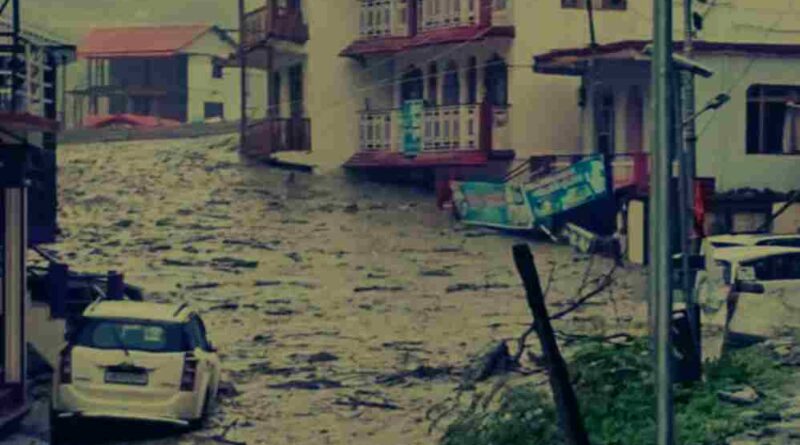Uttarakhand Cloudburst Triggers Landslides and Floods: Lives Lost, Many Missing
A devastating cloudburst struck parts of Uttarakhand early Tuesday, unleashing landslides, flash floods, and widespread destruction across several districts. The sudden deluge, concentrated around the Sahastradhara and Maldevta regions of Dehradun, claimed at least 15 lives, with 16 people still missing as rescue teams continue their operations.
Heavy Rainfall Turns Fatal
According to officials, the rainfall was unusually intense and concentrated. Sahastradhara recorded more than 260 mm of rain within 24 hours, overwhelming rivers and streams. In Nainital, over 100 mm of rainfall was recorded during the same period. The sheer volume of water led to overflowing drains, flooded roads, and landslides that buried homes and swept away vehicles.
Entire stretches of highways and village roads were blocked, cutting off access to several hamlets. Villagers described scenes of panic as rising water entered homes and debris from hillsides crashed down without warning.
Human Toll
The human tragedy has been immense. Rescue teams recovered bodies in Dehradun, Pithoragarh, and Nainital districts. Among the deceased were residents of Uttarakhand as well as migrants from neighboring states and Nepal. Families have been torn apart, with survivors recounting how relatives were swept away in the torrents.
One villager recalled hearing a thunderous roar before boulders and mud engulfed his home. Others described being trapped overnight in waterlogged houses, waiting for help to arrive.
Children, elderly people, and travelers were among those caught in the chaos. In some areas, people clung to trees and rooftops until they were rescued.
Infrastructure and Property Damage
The disaster has caused losses running into tens of crores of rupees. Roads have caved in, bridges have collapsed, and agricultural fields lie submerged under sheets of water.
- Roads and Transport: Key roads linking towns were destroyed or blocked by debris, isolating several villages.
- Houses and Shops: Residential buildings, community centers, anganwadi facilities, and shops have been damaged or reduced to rubble.
- Agriculture: Fields in low-lying areas were inundated, with standing crops washed away, leaving farmers devastated.
- Utilities: Power lines and drinking water pipelines have been snapped, adding to the hardships of survivors.
Government and Relief Response
The State Disaster Response Force (SDRF), local police, and district administration teams were immediately deployed to affected zones. Rescuers are working tirelessly to retrieve missing persons, evacuate stranded families, and distribute relief material.
The government has announced compensation packages for affected families. Those who lost their homes will be provided financial aid and temporary housing support of ₹4,000 per month for the next three months. Relief camps have been set up to provide food, clean drinking water, and medical care.
Chief officials have directed road and irrigation departments to expedite the clearing of blocked routes, repair embankments, and restore essential services.
Why Such Events Are Increasing
Cloudbursts are sudden, extreme rainfall events that often occur in mountainous areas. While common in Uttarakhand, their frequency and intensity appear to be increasing in recent years. Experts point to climate change, deforestation, and unplanned construction as factors that magnify their impact.
The fragile Himalayan terrain is highly vulnerable to landslides, and human interference in natural drainage systems worsens the problem. Poorly designed infrastructure often cannot withstand such heavy rainfall, leading to greater losses when disasters strike.
Preparing for the Future
This tragedy underscores the urgent need for:
- Early Warning Systems: Real-time monitoring of rainfall and river levels to alert residents in advance.
- Resilient Infrastructure: Roads, bridges, and homes must be built with stronger safeguards against landslides and flooding.
- Community Preparedness: Awareness programs, evacuation drills, and local shelters can save lives during sudden calamities.
- Environmental Protection: Reforestation and careful land-use planning are vital to stabilizing slopes and reducing disaster risk.
A State in Mourning, Yet Resilient
Uttarakhand has witnessed natural disasters before, from the Kedarnath floods to recurring landslides. Each time, the resilience of its people shines through — neighbors helping neighbors, strangers offering shelter, and communities standing united.
While the scars of this cloudburst will remain, the tragedy also calls for collective reflection. Protecting lives in the future means not only responding swiftly in emergencies but also planning and building responsibly in the present.
As search and rescue operations continue, families wait anxiously for news of their missing loved ones. The mountains, while majestic and beautiful, remind us once again of their unforgiving power.
Disclaimer
The information and content shared on digitalgithub.com — including articles, blogs, news, guides, and other resources — is intended for general informational and educational purposes only. We do not guarantee the completeness, reliability, or suitability of any information. Always seek the guidance of a qualified professional before making decisions based on the information you read. Use this site at your own risk.

